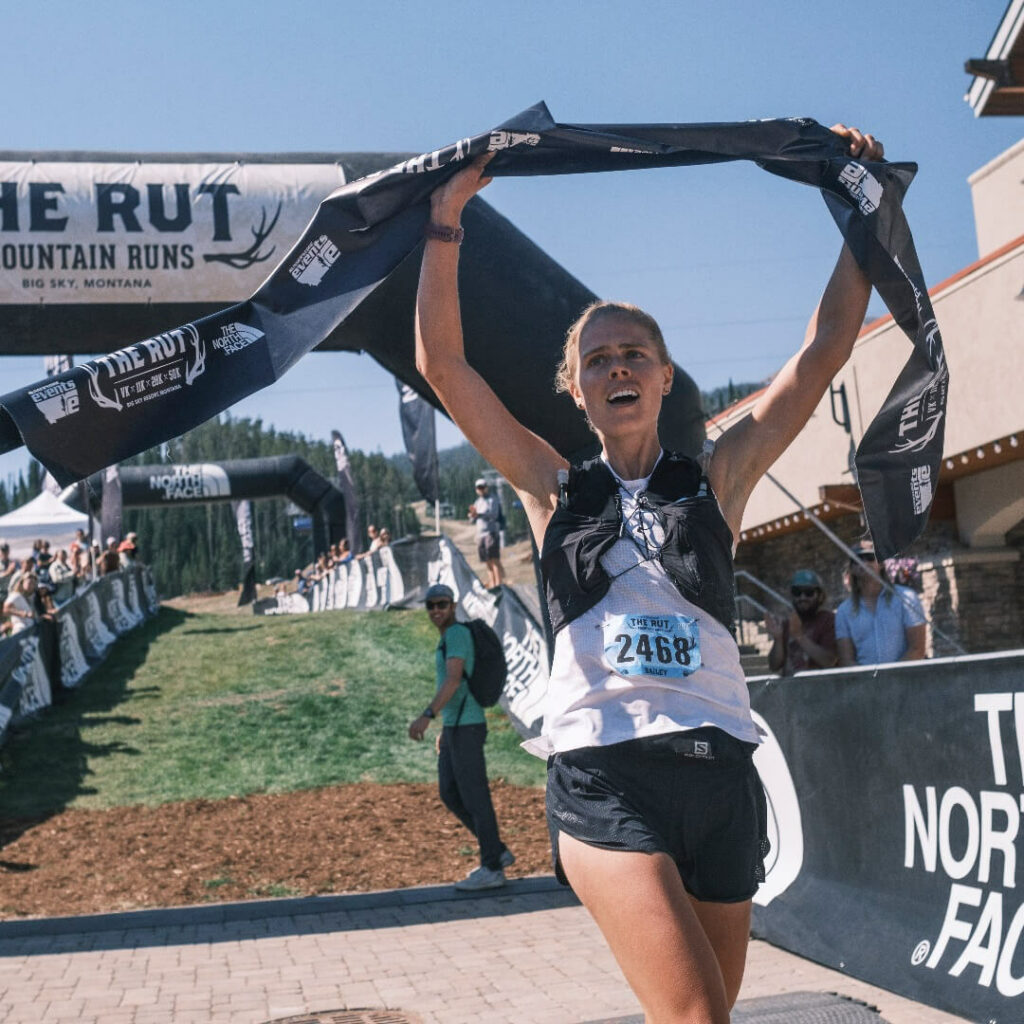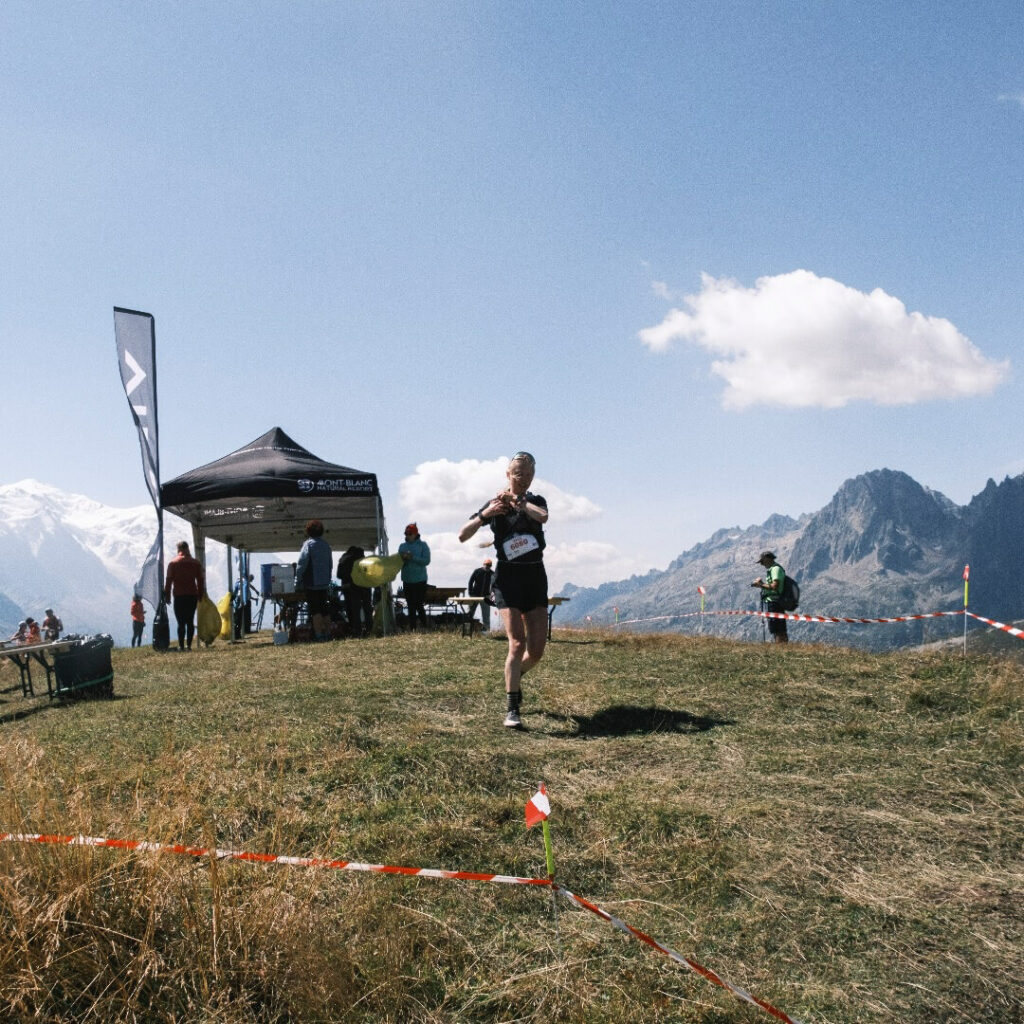Women, running, and the eternal question, “How can we increase female participation in trail and ultra races?“
It’s UTMB 2021. I’m in a holding pen before the start and in the post-Covid era, I’m starting in the “slow” wave according to my ITRA ranking. A member of the organizing team talks over a microphone to the crowd to pass the time. As an engagement exercise, he asks all the men to sit down, and all the women to stand up so they can be recognized for taking part. Despite being surrounded by so many people, it all of a sudden felt very lonely. There were just under two dozen of us standing in the hot sun, in a sea of about 800 runners.
We are repeatedly told that the longer the distances the better women perform. Just last month, Camille Herron helped us all dream bigger with her astonishing performance setting the women’s 48-hour running world record at the 2023 Sri Chimnoy 48-Hour Festival. Her run set an outright American Record for 48 hours, surpassing the previous male record holder, Olivier Leblond. Moreover, RunRepeat looked at 23 years’ worth of ultrarunning data to show that female ultrarunners outperformed men in distances over 195 miles – “the longer the distance, the shorter the gender pace gap.” [Although it is worth caveating this with the fact that, overwhelmingly, as more people do long distance running, the average pace on the whole has slowed.]
In contrast, look at the start lines of the best known trail, ultra and mountain races around the world – it’s a sea of men. The highlight videos – a sea of men. And, when we read race reports and check out the finish line photos – you guessed it, men are significantly more visible than women, again.
But there are a few races running away from the norm. This year, I ran the Tarawera 100-kilometer race in New Zealand. To my surprise, I was surrounded by ladies throughout my run. In the dark, when I was going through a typical low point, I laughed with another female runner who was feeling similarly “over it.” During the climbs, all the ladies I passed cheered me on. An Australian girl and I stopped to wonder at the glow worms in the middle of the night and high five each other. It was a very different experience from any other race I’ve done.
New Zealand, Argentina and Canada lead the way in women’s participation rates, according to the latest State of Trail Running from RunRepeat. At the same time, the more southern a European country, the fewer female trail runners line up to race. Despite the exponential growth the sport is experiencing there is still a mix of low female participation rates across the globe. With trail running growing 231% in the last 10 years (RunRepeat), shouldn’t we naturally see more women taking part? A 2019 RunRepeat report found that more females crossed start lines than male runners overall. However, the primary source of this data came from events up to the marathon distance. When it comes to ultra running, where are the women and why don’t we see them more in our sport’s most prominent events?
Speaking to several female runners who completed the 100-kilometer and 50-kilometer races at Tarawera, none of them felt that they’d been specifically “called out to” as women. And yet, overall, the Tarawera race weekend attracts a field that is 49% women, and includes a huge diversity of ages taking part as well. On the face of it, it’s an ultra event like any other… but perhaps there was more to it than that?

Looking for the answer, I met up with Sophie Power, founder of SheRACES, a global network of champions working to get more women to more start lines, as well as to create the right experience for them in races. Sophie went viral thanks to a photo of her breastfeeding her 3-month old during the UTMB Mont Blanc 170-kilometer race a few years ago. She campaigns for equal opportunities for women to start, enjoy, and celebrate running races and achievements. This includes a push for the UTMB organization to allow pregnancy deferrals – a change that began timidly last year, only to finally become a full-blown initiative to support women in trail running, which happily extends to partners, adoptions, and surrogacy, announced just last month.
How do we get more women running and enjoying trail and mountain ultras? Here are the first three steps, thanks to Sophie and some fantastic gender equality champions.
Step 1: Being in the room where it happens
When race directors first contacted Sophie during the early stages of her campaigning for pregnancy deferrals in ultra running, they simply said, “We’ve never thought about our pregnancy policy, because we’re all men.”
Representation matters, but not just in marketing – it needs to be a cornerstone of race directors’ recruitment policy. Shane Ohly, Race Director for Ourea Events, hit the nail on the head in his recent blog: by having a gender-balanced office team and striving to achieve a similar balance on the ground, Ourea benefits from more women’s input when designing events. And this trickles down into the whole experience.
Sophie mentioned something so simple and evident, yet so easily overlooked, “Often, races aren’t designed with women in mind, but that’s not on purpose.” It’s an inherited bias that we’ve got used to “putting up with.” I don’t mind running a race that hasn’t catered to women specifically, but is that just because I’m used to living with the dominant narrative?
In most cases, the answer is yes. Rosemary, an adventure racer and ultra runner from Scotland, shares that she doesn’t necessarily wonder about the logistics for her as a woman when she lines up for an event. However, when she completed the 8-day Cape Wrath Ultra (an Ourea event) last year, she noticed the female-only toilets when she entered the aid stations. It wasn’t a huge gesture, but it made an instant difference: “I felt seen.”
It’s the kind of thing that you talk about with your friends, casually, that doesn’t mean much in the grand scheme of things. But it starts a process whereby you start to think of going to another event by the same race director or organization. Maybe it leads to you recommending the race to someone you know. And maybe, in a few months, a year, or even longer, there are more women on the start line, enjoying the trails, and partying at the finish line.
Ultimately, it shows the race director considers women, which is the first piece of the puzzle. Sophie campaigns for pregnancy deferrals because it’s a first step to showing women that races care about their participation and that they’re wanted there. It’s also the most obvious difference between men and women – denying women deferral for something that only happens to them creates an immediate barrier. This first step opens the door to a wider discussion around the whole race design.
Small gestures go far, and the more women there are helping make these decisions, the more likely it is that races will be “women-friendly” without much added effort.
Step 2: You can’t be what you can’t see
What’s one thing that the homepage of the Cape Wrath Ultra and Tarawera Ultramarathon have in common? Smiling faces of female trail runners crushing the course.
Unfortunately, we see a stark difference in the way some races introduce themselves to the public. The UTMB organization’s homepage, in fact, used to simply feature the men’s podium until recently – the new homepage has the start line in the background… also dominated by men. The disparity doesn’t end here between male and female representation in ultras, it extends to video coverage, press coverage of the results, and the language used in describing events.
SheRACES have put together recommendations about representation that correlate to some interesting research findings and on-the-ground confirmations.
Photography
Events featuring women in their photography tend to attract more women. Moreover, the emotions conveyed by event photography matter. I’ve heard anecdotes of competitors being told in the race briefing that they shouldn’t smile when meeting official photographers, or they wouldn’t be featured on the website. After all, the event needs to look “tough.” But would you rather enter a race that seems like no fun, or one that looks enjoyable? And who’s more likely to choose one or the other?
Let’s look at the data. High Terrain Events in the UK feature women heavily in their race photography. Their recent races saw 29% women running the 82 km, 41% in the 50k, and 45% in the 32k. It’s a relatively small event, but one that comes across as inclusive and fun – and imagery is a huge part of that. In the US, the Broken Arrow Skyrace landing page features Hillary Allen smashing a climb and there are women on almost every page. It’s subtle, but effective: the 2022 edition had 33% women in the 52k and 44% women in the 26k.
SheRACES advises that equal coverage between men and women is key in race photography and representation on the website. Having women on an event’s website shows that they’re welcome there.
Academic literature has investigated the female gaze and whether female photographers take different pictures compared to their male colleagues. One study states that “generally, female photographers are more drawn to […] emotion” – suggesting that you’ll get raw but more positive imagery when women are behind the lens. However, “pictures aren’t taken in a vacuum. The sex of the photographer matters because subjects react to men and women differently,” according to another paper.
Do races need to hire more female photographers to reach a more diverse audience? Or is it enough to just be mindful of representing female participants in post production? Promoting women in all roles associated with an event seems to be part of the answer, as they will naturally have other women front of mind.

Language
How we talk about events matters. Participant feedback tells a much more complete story than race logistics info ever can, and having that feedback evenly distributed between male and female runners is essential. This is why an event like the High Terrain Events’ Kielder Ultra seems to attract female runners so much more: there are quotes from both men and women sharing their experiences on the home page.
An interesting fact that SheRACES found when running a survey among female runners: 40% are put off entering an event by the logistics. This covers the presence of detailed information on the website, clarity around cut-offs and aid stations, etc. The way things are worded is important, too. Once again looking at the Kielder Ultra, the event’s mission is to offer “challenging but manageable courses, […] to encourage runners of all abilities [and…] promote a relaxed and friendly atmosphere so you can feel at ease, especially if you’re new to ultra running.”
Appropriate language also means respecting women’s competition and results, says Sophie Power. Take, for example, New Zealand’s Kepler Challenge. Their results page lists equal prize money for men and women, as well as male and female race records. It seems simple, but it’s such a far cry from other events, where simply finding the number of female finishers or where a woman ranks against the overall standings can feel tougher than running the race itself.
I could go on when it comes to linguistics and the inherent word associations that races choose to use. There’s one thing to introduce yourself as inclusive, fun, encouraging, “challenging but manageable” – and quite another to boast about being the toughest / hardest / most brutal course. Especially as a beginner, or someone leveling up in their running, encouragement goes a long way towards clicking “Register”. And there can then come a time to boast about “crushing it,” too.
Step 3: Is it just our mentality?
There are, of course, entrenched societal norms and stereotypes when it comes to how men and women are perceived in, and approach, sports. While we cannot change the fact that women have, on average, 5 hours less leisure time a week than men, we can look into changing some perceptions which have become barriers to entry into the world of ultras for female runners.
We all know a guy that will put himself forward for a job he’s not 100% qualified for – the research also supports that. And it’s been documented that women’s barriers to ultra running races are mostly linked to training time. Women are less likely to have as much leisure time than men and are more likely to feel guilty about carving out the time to train for an ultra. What if they could be reassured about speed and cut-offs, to a point where completion of the event felt more manageable?
To address the issue of time shortage and feeling unprepared could be as simple as giving as much information as possible ahead of time. The Broken Arrow Skyrace has a wealth of information about each distance, while High Terrain Events feature recce videos and shots from throughout the course for each of their races. The Tarawera races also excel here: the 100-kilometer race has probably one of the most detailed and clear websites out there. When they changed the course dramatically this year because of flooding, new course maps, GPX files, and detailed information about the changes were uploaded days ahead of the start.

While stereotypes are changing and more women are toeing start lines around the world every day, there’s still a lot to do to make them visible, fully respected, and provided with an enjoyable experience when they tackle trail and ultra events. There is so much more to address. Race directors have to work with time cut-off requirements that can feel unattainable for women. There are, of course, considerations for the time volunteers, safety crews and other staff can be out on the course. There’s a world of work to be done when it comes to ensuring women have a positive experience on the trail (and it’s not just gendered toilets). And there are always caveats and exceptions to every trend.
However, one common theme that emerges from talking to female competitors across distances and experience levels is that small gestures go a long way. Women who feel seen and respected in races amplify that event’s reach and develop loyalty towards it. All it takes is showing interest and starting to include that female point of view. It’s good business, good community building, and a way to develop the trail culture that we all want.
So, what can we do now to support women’s participation in trail and ultra events?
Action starts at the local level and, luckily, there are many great ways to contribute:
- Join and / or support women’s trail running and walking groups – e.g. Trail Sisters events and local communities – and bring a friend;
- Vote with your wallet: Sign up for Trail Sisters and SheRACES approved events whenever you can;
- Volunteer at races to boost the number of female faces in the crowd, or just come out and support more events as spectators;
- Be active in event-specific social media, such as Facebook groups where newbies may be asking questions or seek support;
- Mentor a female runner in your community or volunteer as a pacer or crew member for women at ultra events near you.
